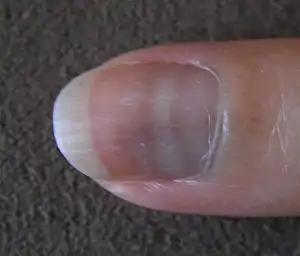Mees' lines
Mees' lines or Aldrich–Mees lines, also called leukonychia striata, are white lines of discoloration across the nails of the fingers and toes (leukonychia).
| Mees' lines | |
|---|---|
 | |
| Specialty | Dermatology |
Presentation
They are typically white bands traversing the width of the nail. As the nail grows they move towards the end, and finally disappear when trimmed.
Causes
Mees' lines appear after an episode of poisoning with arsenic,[1] thallium or other heavy metals or selenium,[2] and can also appear if the subject is suffering from kidney failure.[3] They have been observed in chemotherapy patients.[4]
Eponym and history
Although the phenomenon is named after Dutch physician R. A. Mees, who described the abnormality in 1919,[5] earlier descriptions of the same abnormality were made by Englishman E. S. Reynolds in 1901[6] and by American C. J. Aldrich in 1904.[7]
See also
- Leukonychia
- List of cutaneous conditions
- Muehrcke's nails – a similar condition, except the lines are underneath the nails and so do not move as the nail grows
References
- Hall AH (2002). "Chronic arsenic poisoning". Toxicol. Lett. 128 (1–3): 69–72. doi:10.1016/S0378-4274(01)00534-3. PMID 11869818.
- "Selenium: A Trace Element with Real Potential". Retrieved 31 January 2020.
- Udayakumar P, Balasubramanian S, Ramalingam KS, Lakshmi C, Srinivas CR, Mathew AC (2006). "Cutaneous manifestations in patients with chronic renal failure on hemodialysis" (PDF). Indian Journal of Dermatology, Venereology and Leprology. 72 (2): 119–25. doi:10.4103/0378-6323.25636. PMID 16707817.
- Huang, T.-C.; Chao, T.-Y. (14 December 2009). "Mees lines and Beau lines after chemotherapy". Canadian Medical Association Journal. 182 (3): E149. doi:10.1503/cmaj.090501. PMC 2826482. PMID 20008502.
- Mees RA (1919). "Een verschijnsel bij polyneuritis arsenicosa". Ned Tijdschr Geneeskd (in Dutch). 1: 391–396.
- Reynolds ES (1901). "An Account of the Epidemic Outbreak of Arsenical Poisoning occurring in Beer Drinkers in the North of England and the Midland Counties in 1900". Lancet. 1 (4038): 166–70. doi:10.1016/S0140-6736(01)81229-0. Reprinted in Reynolds ES (1901). "An Account of the Epidemic Outbreak of Arsenical Poisoning occurring in Beer Drinkers in the North of England and the Midland Counties in 1900". Med Chir Trans. 84: 409–52. PMC 2036791. PMID 20896969.
- Aldrich CJ (1904). "Leuconychia striata arsenicalis transversus, with report of three cases". Am J Med Sci. 127 (4): 702–709. doi:10.1097/00000441-190412740-00014.